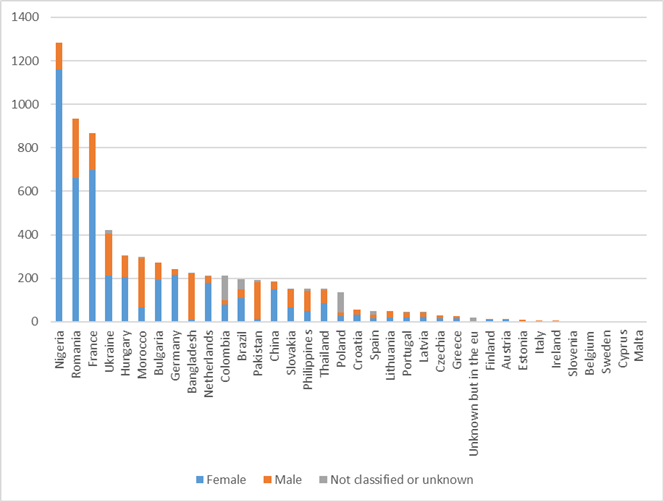
On 24 January, EUROSTAT published the 2022 statistics for trafficking in human beings. The newly released data show that 10,093 victims of trafficking in human beings were registered in the EU in 2022, representing a 41% increase compared to 2021. This increase may be the result of higher detection rates of victims thanks, among other things, to awareness raising actions across the EU in 2022 to prevent trafficking of those fleeing the military aggression against Ukraine.
Similarly to 2021, more than half of all the victims in the EU are women and girls (63%). In the cases where the victim’s age group is known, children make up 15% of the victims. This represents a drop compared to 2021. The majority of child victims are female (75%).
The share of EU nationals among the registered victims is 37%, representing a significant decrease compared to 2021. Across the EU, approximately 25% of all registered victims are citizens of the country in which they were registered, which constitutes a 19% decrease compared to 2021.
For the first time, the number of registered victims for labour exploitation (3,990) came close to the number of victims sexually exploited (4,014), each amounting to about 41%. Trafficking for other purposes – criminal activities, forced begging, organ removal and others – reached a total of 1,699 victims (18% of all trafficking victims).
The number of suspected traffickers decreased by 16% (8,064 in total) and the number of convicted traffickers decreased by almost 17% (2,097) in 2022 compared to 2021.

Detection of victims remains of key importance
The increase in the number of victims in 2022 could be due to higher detection rates, as action was taken across the EU to raise awareness and help victims come forth. This happened in 2022, more specifically in the context of preventing trafficking of displaced people fleeing Ukraine.
From the development and dissemination of leaflets raising awareness of the risks of trafficking and informing people, including workers, about their rights, to the exchange of information and best practices among labour inspectorates and national authorities under the European Platform tackling Undeclared Work, or training delivered by CEPOL, numerous actions have been implemented to raise awareness and fight trafficking in human beings.
Moreover, cooperation among EU countries, with the support of EU agencies, such as Europol, Eurojust, and the European Labour Authority, led to more successful investigations into labour exploitation. For instance, a joint operation in June 2023, led by the Netherlands and involving police and labour authorities from 31 EU and non-EU countries, resulted in the arrest of 21 suspects and the identification of 261 potential victims of trafficking for labour exploitation.
As in previous years, the actual number of victims is likely significantly higher than data suggests, as these statistics only capture victims that become known to one of the registering entities and many victims still remain undetected.
Find out more
Eurostat – Trafficking in human beings statistics
Together against trafficking in human beings
End human trafficking. Break the invisible chain campaign
EU Anti-Trafficking Coordinator
Details
- Publication date
- 28 February 2024
- Author
- Directorate-General for Migration and Home Affairs
